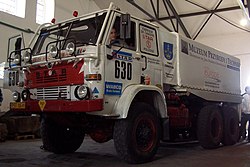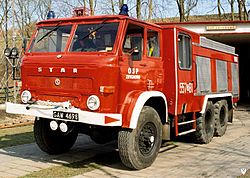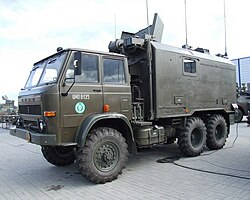| Star 266 | |
|---|---|
 | |
| Overview | |
| Manufacturer | FSC Star |
| Production | 1973 - 2000 |
| Assembly | Poland |
| Body and chassis | |
| Class | 6x6 Truck |
| Related | Star 200, Star 244 |
| Powertrain | |
| Engine | STAR 359/359M 6-cylinder diesel 150 hp |
| Transmission | S5-45 5-speed |
| Dimensions | |
| Length | 6820 mm |
| Width | 2500 mm |
| Height | 2660 mm - 3155 mm |
| Curb weight | 7.35 tonnes |
| Chronology | |
| Predecessor | Star 660 |
| Successor | Star 1466 |
The Star 266 is a Polish 6x6 truck designed for transport of cargo and personnel. Created by Starachowice-based FSC Star, it was the basic transport truck used by the Polish Army. It was also available to the civilian market. A successor to the highly successful Star 660 series of trucks, the Star 266 shared many components with earlier models, including Star 200 and Star 244 multi-purpose medium-capacity trucks.
Contents
The truck could transport up to 3500 kilograms (7716 lbs) cross-country and up to 5000 kg (11023 lbs) on paved roads. It could also tow trailers of up to 4000 kg (8818 lbs). As a truck designed primarily with military service in mind, it can ford rivers and mud of between 120 and 180 centimetres of depth. It was initially equipped with a 6-cylinder S359 diesel engine (6842 cm³, 150 HP). [1]
The design works started in 1968. The following year the first prototypes were ready. Between 1970 and 1973 the vehicle was prepared to enter serial production which it did in 1973. It remained in production until 2000, when it was replaced by Star 1466.




